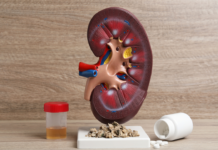Sponsored by: Renadyl™
Every day, kidney patients across the world undergo kidney dialysis treatment. They perform this treatment either at home or in an outpatient kidney dialysis clinic. What many patients don’t see is how their blood is being cleaned during the dialysis process. During dialysis, the blood is cleaned by a solution called dialysate.
What is dialysate?
Dialysate is the clear solution that bathes/cleans the blood during the dialysis treatment. Some of the ingredients inside the dialysate include salt (sodium, potassium, calcium…), sugar (dextrose), and treated water. The concentration of these ingredients is similar to their concentration in the blood. If you take a look at the dialyzer (artificial kidney) during a dialysis treatment, you will see four plastic lines attached. Two are filled with blood (the blood lines) and two are filled with dialysate. Inside the dialyzer, the blood and dialysate are separated by a thin semipermeable membrane. This membrane is shaped like straws. Each “straw” is called a hollow fiber. The blood flows inside each hollow fiber while the dialysate flows outside of the hollow fiber.
Dialysate and the dialysis process:
Dialysis occurs when molecules or fluid move through the tiny pores (holes) located in the walls of the straw. With diffusion, particles always move from a higher concentration to a lower concentration. By controlling the concentration or makeup of the dialysate, we can control which particles will “diffuse” out of the blood (move from the blood to the dialysate), which will diffuse into the blood (move from the dialysate to the blood), or which will not change (no movement will occur). For example:
- Potassium: Since most kidney failure patients have extra potassium in their blood, the concentration of potassium in the dialysate is usually set lower than its concentration in the blood. Diffusion then causes the extra potassium to move from the blood to the dialysate, and down the drain. The patient goes home with a lower potassium level than when they arrived for the treatment.
- Bicarbonate (similar to baking soda): Kidney failure causes a person’s blood to become acidic. The bicarbonate in the dialysate helps “neutralize” this extra acid. Diffusion causes the bicarbonate in the dialysate to move into the bloodstream, where this neutralization occurs.
Two other electrolyte concentrations that can also vary in the dialysate are sodium and calcium. The kidney doctor orders the dialysate concentration for each patient. If you don’t know your dialysate prescription, ask your dialysis team or doctor.
Learn more about our sponsor Renadyl here https://bit.ly/3sZDWbb
About the author
Steven Belcher, RN, MSN, MS, is a dedicated kidney advocate who began his journey 20 years ago as a dialysis nurse. This job inspired him to help as many people with kidney disease as he could. Not only did he spend two decades caring for a patient’s physical and emotional needs in a clinical setting, but he also educated the public on the risk factors of kidney disease. Some of his many philanthropic successes include being a keynote speaker at the National Association of Nephrology Technicians/ Technologists (NANT), presenting at community spaces, and launching radio shows.
He now focuses his time entirely on his organization Urban Kidney Alliance, which educates the public about kidney disease. His goal? To lower rates of Chronic Kidney Disease in urban communities in Baltimore, Maryland, across the country, and globally through education and collaboration.
Steve has also written the book “HOW TO SURVIVE OUTPATIENT HEMODIALYSIS: A GUIDE FOR PATIENTS WITH KIDNEY FAILURE.” You can read the book review here.
*These statements have not been evaluated by the US Food and Drug Administration. This information is not intended to diagnose, treat, cure, or prevent any disease. Always consult with a qualified healthcare professional prior to beginning any diet or exercise program or taking any dietary supplement. The content on our website is for informational and educational purposes only.




